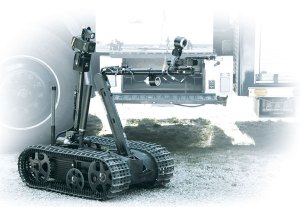According to a report from MarketsandMarkets, the global unmanned ground vehicle (UGV) market is projected to grow from USD 6.44 Billion in 2015 to USD 18.65 Billion by 2020, at a CAGR of 23.7% during the forecast period. This sounds quite impressive, so let’s have a more detailed look at the enabling technologies needed to ensure more widespread adoption. UGVs can be used for many applications where it may be inconvenient, dangerous, or impossible to have a human operator present. Today’s UGVs can be powerful force multipliers and intelligent additions to tactical operations, and UGVs have already been used in thousands of counter-IED missions which made them indispensible in Iraq and Afghanistan. UGVs will have an important and growing role in future ground missions too. Enabled by computing technology advancements, developed to push the environmental limits of unmanned systems, they are key elements in the support RS JPO UGS R (Robotic Systems Joint Project Office Unmanned Ground Systems Roadmap). And of course, extending the capabilities of ground operations and keeping combat units out of harm’s way, UGVs must continue to make mission-critical system survivability priority number one.
Next-generation UGV solutions should continue to progress and at the same time be ‘affordable and cost-effective’

Initial UGV design progression was hampered because they were typically based on proprietary technologies in response to quick deployment needs or service-specific requirements. While they have proven their worth in saving lives, theDepartment of Defense (DoD) has also directed that next-generation UGV solutions continue to progress and at the same time be ‘affordable and cost-effective’ in a time of decreasing budgets. Understanding the severe operating conditions UGVs encounter, the DoD has also specified that these systems must meet or exceed identified reliability goals to ensure they can accomplish their missions once they’ve been deployed. Therefore, the unmanned roadmap identifies a variety of low-cost, easy-to-operate and flexible vehicle types based on mission profiles. With literally dozens of specific UGVs defined and more on the horizon, each service branch has their own specific strategy for UGV deployments classified under field light, medium and heavy UGVs. Vehicle types cover the spectrum from heavy All Purpose Remote Transport Systems (ARTS) and medium Multifunction Utility/Logistics Equipment (MULE) vehicles to light man-portable vehicles such as the Dragon Runner and ultra-small “throwbots”.
Based on COTS computing platforms, UGV designs can more easily meet a long and growing list of requirements
Helping to propel UGV innovation is the availability of continuing advancements in open architecture COTS computing platforms. Based on these platforms, UGV designs can more easily meet a long and growing list of interoperability, modularity and communications requirements and autonomous operation capabilities. Contributing to many of the aspects called out in the RS JPO UGS R, advanced COTS-based technologies inherently reduce lifecycle costs across all systems due to their interoperability and modularity, improved communications capabilities and the ability to support complex integration of such systems as weapons payloads. In addition to simplifying upgrades and helping developers avoid time-consuming design re-qualification, COMe modules can be switched out without affecting carrier board customization, which gives longer lifecycle support for customized systems. Latest processors deliver high performance that can be integrated into small form factor systems for enhanced UGV image resolution, mission-critical communications and network throughput.
Here is a short overview on current UGV requirements:
-
Ability to withstand harsh environmental conditions where shock and vibration, dust, weather, obstacles, terrain and even hostile electromagnetic and cyber environmental concerns are all constant issues
-
Supports situational awareness with safety-critical operation, advanced robotics and efficient operator control functionality
-
Affordable and cost-effective
-
Adheres to SWaP-C (Size, Weight, Power and Cooling) Offers seamless interoperability
-
Platforms must be ‘simple and supportable by the operators and maintainers in the field’ to maximize their usability and viability.
-
Provides efficient thermal management from components that include a rugged baseboard, power module, fully-sealed housing, appropriate I/O connectors and options for future customized I/O.
-
Based on power-conscious processors and offers efficient system operation to minimize the thermal impact on the UGV
-
Features increased sensor capabilities or intelligent payloads combined with the ability to change or update any of these based on specific mission profiles.
-
Offers persistent support of 24 hours or longer as battery power is seen as one of the biggest limitations of any unmanned vehicle
-
Based on high performance embedded computing (HPEC) platforms to address future cloud computing, multilayer security and evolving communications requirements.
-
Secure connectivity
Future outlook
Future trends will pave the way for increased real-time analysis of multiple situations by single operators, allowing UGV’s to perform its assigned mission autonomously. Next-generation communications functionality will need to offer simple plug-and-play payloads that are easily and cost-effectively updated or upgraded. They also must provide the ability to be Internet of Things (IoT)/secure compute-enabled to permit the linking to worldwide enterprise gateway and data center assets. Connecting disparate devices from all authorized DoD systems will help expedite the delivery of mission-critical information for vital real-time decisions. The DoD will continue to stress further reductions to SWaP-C of military platforms to improve mobility and accommodate new payloads while reducing costs.
What future developments do you expect from UGVs?

{{comment.comment}}